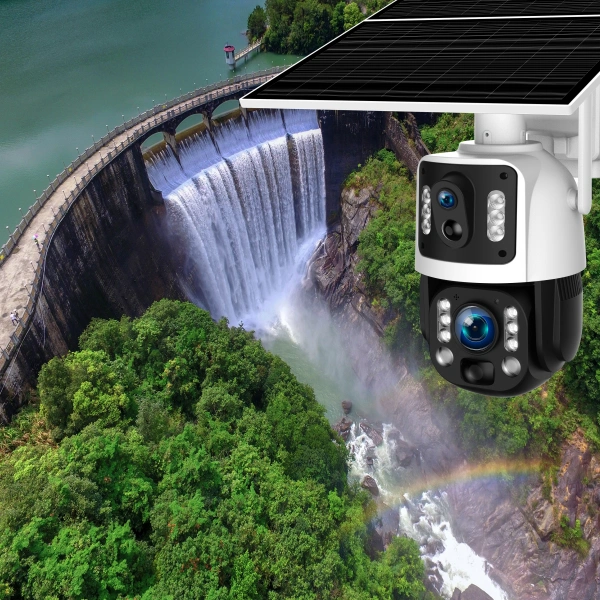Environmental Monitoring Solutions: Using 4G Solar Cameras for Wildlife Protection, Flood Prevention, and Wildfire Alert
Monitoring our planet’s most critical and remote environments presents a monumental challenge. How do you track wildlife in a vast preserve, get early warning of a rising river in an isolated valley, or detect the first wisp of smoke in a sprawling forest? These locations lack the two things traditional technology needs most: power and a data connection.
For decades, this meant data collection was sporadic, expensive, and often too late to be effective.
Today, a new generation of autonomous technology is changing the game. 4G solar-powered cameras have evolved from simple security devices into robust, mission-critical instruments for environmental monitoring. They are the always-on, autonomous eyes in the wild that researchers, conservationists, and safety agencies have been waiting for.
The Technology: How an Autonomous Eye in the Wild Works
This capability is made possible by the convergence of three key technologies:
- True Autonomy (Solar & Battery): With high-efficiency solar panels paired with massive-capacity batteries (like our 20,800mAh long), these cameras can operate for months on end without human intervention. This drastically reduces the cost and disruption of field visits.
- The Data Lifeline (4G LTE): The built-in 4G connection is the lifeline. It transmits critical alerts, images, and video from the most remote locations directly to your phone or command center in seconds, enabling a real-time response.
- Intelligent Sensing (PIR, AI, Time-Lapse): These are not just passive video recorders. They use PIR intelligent detection to wake and record only when an animal’s body heat is detected, saving immense power. They can also be programmed for time-lapse recording to monitor slow-moving changes, like rising water levels or snowpack melt.
Blueprint in Action: Three Critical Environmental Missions
This technology unlocks new possibilities across multiple environmental fields.
Mission 1: Non-Invasive Wildlife Protection & Research
For wildlife biologists and conservation officers, the goal is to observe without being observed. 4G solar cameras are a perfect solution.
- Behavioral Studies: Deploy cameras along game trails to capture natural animal behavior without human scent or presence.
- Anti-Poaching: Get instant alerts. A camera like the SDL500-36X can use its PIR sensor to detect human presence in a protected area and send an immediate alert to ranger teams, complete with an image of the intruder.
- Population Counts: Use multiple cameras across a habitat to gather data for more accurate population estimates.
Mission 2: Proactive Flood Prevention & Water Management
Flash floods in remote areas can be devastating because warnings come too late. A 4G camera provides a simple, powerful early warning system.
- Visual Verification: Mount a camera aimed at a pre-marked water level gauge (a simple painted pole or sign).
- Time-Lapse Monitoring: Set the camera to send an image every hour. This creates a visual record of the water’s rise and fall, allowing water managers to see trends and issue alerts long before downstream sensors are triggered.
- Infrastructure Safety: Monitor remote dams, spillways, and bridges for blockages or damage after a storm.
Mission 3: Early Wildfire Detection & Response
In wildfire prevention, every second counts. The goal is to spot a fire when it’s a single plume of smoke, not a raging inferno.
- The Digital Watchtower: A 4G PTZ (Pan-Tilt-Zoom) camera like the SDL500 can be mounted on a hilltop or tower.
- Automated Patrols: Program the camera to automatically pan across a vast expanse of forest, acting as a tireless 24/7 watchtower.
- Instant Confirmation: When smoke is spotted, a remote operator can immediately take control, zoom in to confirm the location and scale of the fire, and relay precise coordinates to fire crews, dramatically accelerating response times.
Selecting the Right Tool for the Mission: A Field Guide
Not all missions are the same. Choosing the right camera is critical for success.
- The Workhorse (Fixed Monitoring): For monitoring a specific location like a game trail, a river gauge, or a sensitive nesting site, a robust bullet camera like our SDL500 is ideal. It’s discreet, power-efficient, and built to withstand the elements.
- The Watchtower (Broad Surveillance): For scanning wide areas like a forest canopy or a large valley, a PTZ camera like our SDL500 is the superior choice. Its ability to pan and zoom provides situational awareness over a much larger area from a single point.
Why UBOXCAM for Environmental Field Operations?
At UBOXCAM, we engineer solutions for the world’s harshest and most remote environments. Our “Farm Guard” and “Construction Site Eagle Eye” series are trusted in off-grid locations every day. We understand that for environmental monitoring, reliability isn’t a feature—it’s the entire mission. Our cameras are built with industrial-grade components, weather-sealed housings, and power systems designed for long-term, autonomous deployment.
We provide the tools so you can focus on the data.

